IJCRR - 12(23), December, 2020
Pages: 173-178
Date of Publication: 07-Dec-2020
Print Article
Download XML Download PDF
Kamal Patra as an Antidote in Dhatura Poisoning in Albino Mice - In Vivo Study
Author: Asha Kaikade, Anuja Vasant Nagrare, Sonali Dilip Wairagade, Tanvi Wairagade, Vinayak Shegaonkar
Category: Healthcare
Abstract:Introduction: Dhatura (Dhatura metel) is cerebrotoxic, Deleriant poison which is also classified as Upavisha in Ayurveda. Various poisons have been described in Ayurveda along with their antidotes. Mode of action of these antidotes is not mentioned in texts. In Ayurvedic literature According to Basavrajeeyam under the heading of Vish-Prativishani, Chincha Rasa and Kamal Patra churna have been described to be possessing antidote action which may act by some way to counter toxicity of Dhatura. It is necessary to verify the efficacy of these antidotes on scientific parameters so that it can be useful in emergencies.
Objectives: To establish the action and mechanism of Kamal Patra Churna against toxic effects of Dhatura on albino mice. Methods: Swiss albino mice were selected as an animal model and antidote potential of kamal patra against datura poweder is evaluated by measuring body temperature, time of convultions and survival rate.
Results: Kamal patra administration before datutal poisoning reduced the toxic effects of datura such as hypothermia, convulsion and increased the survival rates.
Conclusion: From this study, we can conclude that Kamal Patra can resist the toxic effects of Dhatura up to some extent.
Keywords: Dhatura, Kamal Patra, Agad, Toxicity, Antidote
Full Text:
Introduction
In the ancient era,Ayurvedawas considered as one of the advanced faculty worldwide. Agadtantra is the branch of Ayurveda which deals with the toxicity of various snakes, spiders, insects, rats etc. animals and its treatments. The word ‘Gada’ means poison and the antidote used is called as ‘Agada’.1According to modern science, Toxicologyis the branch which deals with the study of poison regarding theirsources properties, mode of action, symptoms which they produce, lethal dose, fatal period, treatment of their detection estimation & autopsy findings.2,3Dhatura (Dhaturametel) is cerebrotoxic, Deleriant poison which is also classified as Upavisha in Ayurveda.4,5
It is a genus of poisonous herbs shrubs, up to the height of 3–4 ft. This plant has been noted for intoxicating, narcotic properties, they produce temporary insensibility (stupefying effects) in ordinary doses. A bitter taste, dryness of mouth and throat, burning pain in the stomach dysphasia, headache and difficulty in talking are the first symptoms that are complained of. These are followed by giddiness, staggering gait, in the co-ordination of the muscles,the peculiar flushed appearance of the face, dry hot skin, photophobia, dilated pupils, delirium & drowsiness. Sometimes, exfoliations of the skin are seen over most of the body. The pulse becomes irregular and intermittent. In fatal cases drowsiness passes into stupor convulsions, coma, death occurs usually from respiratory failure.
Various poisons have been described in Ayurveda6-8along with their antidotes. These antidotes are readily available in nature. Mode of action of these antidotes is not mentioned in texts.In Ayurvedicliterature according to Basavrajeeyam under the heading of Vish-Prativishani, ChinchaRasa and KamalPatrachurna has been described to be possessing antidote action which may act by some way to counter toxicity of Dhatura.9-11Kamal(Nilumbonuciphera) is a beautiful aquatic plant with a wide range of medicinal usage. It is Madhura,TiktaRasatmak and ShitaVirya hence reduces Pitta Dosha.12-14 Main chemical constituents of Kamal are Nuciferine,10-Nonacosanol, Nelumboside, Neferine, Nuciferin, NelumbineQuecitring,
It is necessary to verify the efficacy of these antidotes on scientific parameters15 so that it can be useful in emergencies. Hence present study entitled “Kamal Patra as an Antidote in Dhaturapoisoning in micewas carried out to establish the action and mechanism of KamalPatraChurna against toxic effects of Dhatura on albino mice.
Material and Methods:
Collection of material
Seeds of Dhaturametelwere collectedin December to January so at that time seeds can be collected from dried fruit.
The collection of leaves of Kamal (Nelumbo nucifera) for the study was done. Collected leaves were dried in shade. The samples were used in powder form.
Procedure –
1. Dhaturametel: 1gm coarse powder of Dhatura seeds choorna were extracted with 70% alcohol in the warm water bath with occasional shaking for ½ hr. in closed tubes, successively with the batches of 3,2 and 1 ml of alcohol. 10μl of the pooled extract was spotted on TLC plate silica gel F254,Merk and was developed in Toluene: ethyl Acetate: Diethylamine (7:2:1).
Detection of Rf Values of the spot was done by using 5% methanolic sulphuric acid reagent. Rf value of visualized spots was given in table no.7
2) Nelumbo nucifera: 1gm coarse powder of KamalPatra Choorna were extracted with 70% alcohol inthe warm water bath with occasionalshaking for ½ hr. in closed tubes, successively with the batches of 3,2 and 1 ml of alcohol .10μl of the pooled extract was spotted on TLC plate silica gel F254,Merk and was developed in Toluene: methanol: pyridine (8:1:1). Rf value of visualized spots was given in table no.8 and 9
Animal Experiment
Material for In Vivo study
Swiss Albino mice of age 90-100 days and weight ranges 20-25 gm were procured. Poisoning was induced by Dhatura seed and test drug was kamalpatra powder.
Determination of acute toxicity of Dhatura
Acute toxicity test (LD50 determination) of the extract of Dhatura seeds is performed as per guideline of OECD in Swiss Albino mice.
Determination of protective action of Kamal Patra against toxicity of Dhatura seed
Reduction in mortality and change in behaviour of mice due to a lethal dose of Dhatura seed after administration of Kamal leaves are determined.
Dose Calculation
Dose Calculation for Albino Mice
The conversion factor from man to mice is 0.0026 so according to this, all the doses were calculated. Dose for mice was obtained from the following formula
Dose of mice = 0.0026 X Dose of Man
Dose Calculation for Dhatura Seeds
Human fatal Dose for Dhatura Seeds is considered as 100 – 120 crushed seeds i.e. calculated as 1400 mg. According to the conversion factor, fatal dose in albino mice for Dhatura is 3.64 mg
Hence per kg wt. Fatal dose for albino mice = 03.64 x 50
= 182 mg/kg
Dose Calculation for Kamal Patra Powder
Human therapeutic dose of Kamal Patra is considered as 3 gm – 6 gm. According to the conversion factor, fatal Dose in albino mice for Kamal Patra is 7.8 to 15.6 mg
The dose I: Per kg wt. dose for albino mice = 7.80 x 50
= 390 mg/kg
Dose II: Per kg wt. dose for albino mice = 15.6 x 50
= 780 mg/kg
Procedure
Drug samples were converted into suspension by careful mixing with distilled water.Both drugs were administered orally.After administering the dose all animals were observed for 24 hours for toxic sign and symptoms or mortality up to 7 days.First preliminary drug toxicity study for Dhatura was done. In each group weight of each animal was taken and noted, simultaneously dose of Dhatura and Kamal Patra were calculated accordingly.Samples of Toxic drug and Antidote were given by oral route.After dosing; the animals were observed for 24 hrs and up to 7 days. Comparative observations were tabulated( Table 2).
Group I: Acute toxicity of Dhatura Seed churna(N=6)
Group II:Kamal Patra churna(Dose 1) + Dhatura Seed churna(N=6)
Group III:Kamal Patra churna(Dose 2) + Dhatura Seed churna(N=6)
Parameters:
-
Change in Temperature
-
Appearance of Convulsions
-
Dilatation of Pupils
-
Survival period(death)
Results AND Discussion
Analytical Study
Laboratory experiments were carried out to obtain values of following parameters for Dhatura seeds, KamalaPatra the observation and results follow( Table1-5)
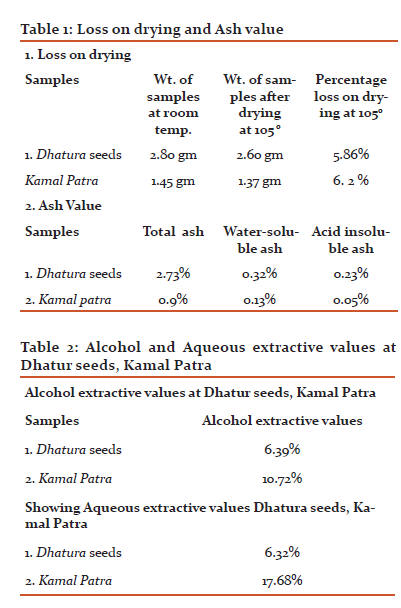
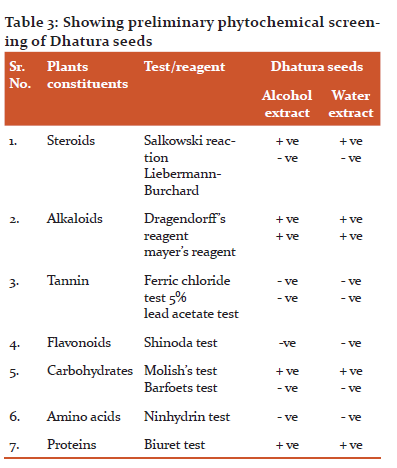
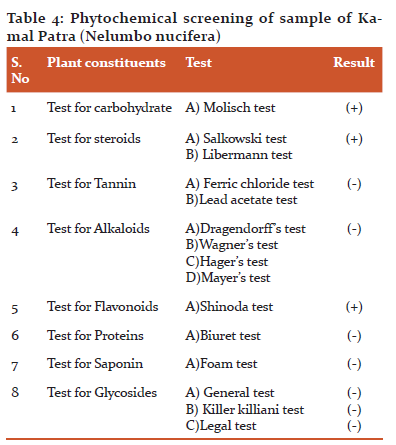
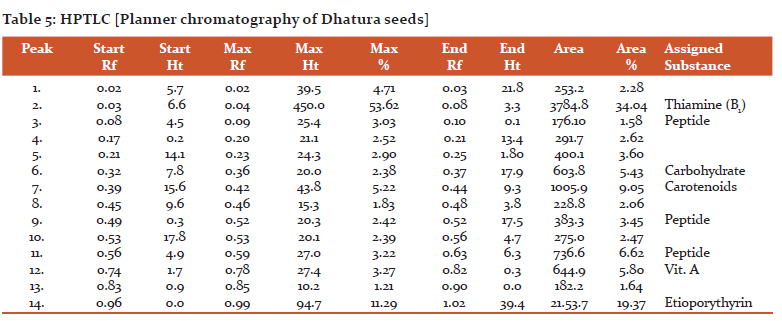
Effect of poisoning and kamalpatar in animals
Changes in body Temperature
The observations were analyzed statistically by one way ANOVA Test. The P-value suggested significant changes (Table 6A and B).The mean change in body temperature in group 1 was 38.14±0.43. While in Group 2 it reduced to 37.44±0.37 and further in Group 3 it reduced down to 37.08±0.33. The observations were analyzed statistically by one way ANOVA Test. The P-value suggested significant changes.Further, the groups were compared with each other with the help of Tukey Kramer Multiple Comparison Test. Comparison of Group 1 with Group 2 and Group 2 with Group 3 suggested statistically Non Significant changes. While Comparison of Group 1 with Group 3 suggested Mean difference of 1.0630 and Q value 4.798 which is statistically significant.

Time of the appearance of Convulsions
The observations were analyzed statistically by one way ANOVA Test. The P-value suggested Non-significant changes ( table7A and B). The mean change in the time of appearance of Convulsion in group 1 was 153.32±7.33. While in Group 2 it increased to 159±4.91 and further in Group 3 it increased up to 166.43±874. The observations were analyzed statistically by one way ANOVA Test. The P-value suggested Non-significant changes. Further, the groups were compared with each other with the help of Tukey Kramer Multiple Comparison Test. Comparison of Group 1, Group 2 and Group 3 suggested statistically Non-Significant ( Graph 1,2).

Time of Dilation of Pupil
The mean change in the time of dilatation of Pupils in group 1 was 111.89±6.79. While in Group 2 it increased to 119±6.04 and further in Group 3 it increased up to 133.58±7.57. The observations were analyzed statistically by one way ANOVA Test. The P-value suggested significant changes. Further, the groups were compared with each other with the help of Tukey Kramer Multiple Comparison Test. Comparison of Group 1 with Group 2 and Group 2 with Group 3 suggested statistically Non-Significant. Comparison of Group 1 with Group 3 suggested Mean difference of 21.79 and Q value 5.50 which is statistically Significant. The observations were analyzed statistically by one way ANOVA Test. The P-value suggested significant changes (Table 8A, B).

Duration of Survival period
The mean change in the time survival Period (Death) in group 1 was 370.36±24.99. While in Group 2 it increases to 402.35±17.88 and further in Group 3 it increases up to 424.51±22.72. The observations were analyzed statistically by one way ANOVA Test. The P-value suggested Non-significant changes.
Further, the groups were compared with each other with the help of Tukey Kramer Multiple Comparison Test. Comparison of Group 1, Group 2 and Group 3 suggested statistically Non-Significant. Further, the groups were compared with each other with the help of Tukey Kramer Multiple Comparison Test. Comparison of Group 1 with Group 2 suggested Mean difference of 31.99 and Q value 2.51 which is statistically Non-Significant. Comparison of Group 1 with Group 3 suggested Mean difference of 54.15 and Q value 4.25 which is statistically Non-Significant. Comparison of Group 2 with Group 3 suggested Mean difference of 22.16 and Q value 1.73 which is statistically Non-Significant.
The observations were analyzed statistically by one way ANOVA Test. The P-value suggested Non-significant changes ( Table9A and B).
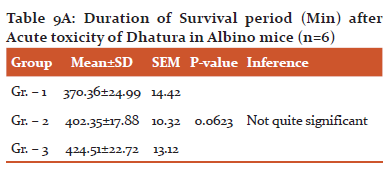
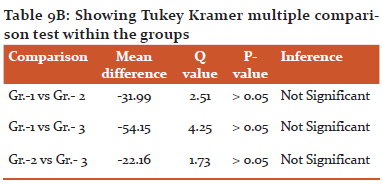
Conclusion
Dhatura is neurotoxic cerebral deliriant poison which is also classified as Upavisha in Ayurveda with ‘9 Ds’ toxic effects.The active principle is dhaturine containing hyoscine, hyocymine and atropine. It blocks the acetylcholine receptors and thus produces sympathomimetic or parasympatholytic actions (Anticholinergic actions). In vivo study of Antidote properties of Kamal Patra shows, hyperthermia caused due to toxicity is significantly reduced, duration of the appearance of convulsions is increased slightlybut it is statistically insignificant, duration of dilatation of the pupil is significantly increased, rise in duration if the survival period is statisticallyinsignificant but a slight rise was seen in it.
Financial Support and Sponsorship
Nil
Conflicts of Interest
There are no conflicts of interest
References:
-
Amarasimha; Amarakosha; 4thEd, edited by Pt Haragovinda Shastri; Varanasi; Chaukhambha Sanskrit Samsthan; 2001.
-
Agnivesha, Revised by Charaka and Dhradabala; Charak Samhita with The Ayurveda – Dipika Commentary of Chakrapanidatta, Edited by JadavajiTrikamji Acharya, ChaukhambhaSurbharatiPrakashan, 2000.
-
Sushruta; Sushruta Samhita; with the NibandhaSangraha commentary of Sri Dalhanacharya; Reprint edition, Edited by JadavajiTrikamji Acharya, Varanasi; ChaukhambhaSurbharatiPrakashan; 2012.
-
Shastri A, Sushruta Samhita, Choukhmba Sanskrit Sansthan, Varanasi, edition 2011.
-
Vagbhata, Ashtanga Hridaya, With the Commentaries Sarvangsundara of Arunadatta and Ayurvedarasayana of Hemadri, edited by S.S.Paradakara, 9th Ed., ChaukhambhaSurbharatiPrakashan, 2011.
-
Sharangdhar P, Sharangdhar Samhita: -[Hin.] Edi. By Pandit ParasuramaSastri, ChaukhambhaOrientalia, Varansi, Edition. 2012.
-
Shastri K, Rasatarangini, 11th edition, Motilal Banarasidas Delhi, 1976
-
Nighantu M, LaxmivyankateshKayan Publication Mumbai, 1962
-
Sharma P, Kaiyadev Nighantu, Ist Edition, Choukhamba Orientalia, Varanasi
-
Nighantu B:With Vidyotini Hindi Commentary Edi. By Pandey, Chaukmbha Bharati Academy; Varanasi, Ed. 2010
-
Mahajan B. Methods In Biostastics, Jaypee Brothers Medical Publishers (P) Limited, Noida, 2004, 7th Edition, 2010.
-
The Wealth of India: Raw Materials, Council for Scientific and Industrial Research New Delhi, 1962.
-
The Ayurvedic Pharmacopoeia of India: 1st Ed, Govt of India,The controller of publications, Delhi.
-
Reddy S, The essentials of forensic medicine and Toxicology 28th edition Parikh’s Textbookof Medical Jurisprudence Forensic Medicine and Toxicology, 6th edition CBS publishers anddistributors, New Delhi 1999
|






 This work is licensed under a Creative Commons Attribution-NonCommercial 4.0 International License
This work is licensed under a Creative Commons Attribution-NonCommercial 4.0 International License